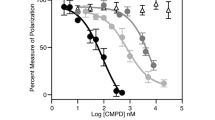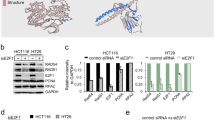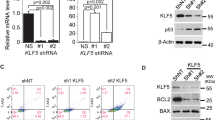Abstract
Deregulation of the Rb/E2F pathway in human fibroblasts results in an E2F1-mediated apoptosis dependent on Atm, Nbs1, Chk2 and p53. Here, we show that E2F1 expression results in MRN foci formation, which is independent of the Nbs1 interacting region and the DNA-binding domain of E2F1. E2F1-induced MRN foci are similar to irradiation-induced foci (IRIF) that result from double-strand DNA breaks because they correlate with 53BP1 and γH2AX foci, do not form in NBS cells, do form in AT cells and do not correlate with cell cycle entry. In fact, we find that in human fibroblasts deregulated E2F1 causes a G1 arrest, blocking serum-induced cell cycle progression, in part through an Nbs1/53BP1/p53/p21WAF1/CIP1 checkpoint pathway. This checkpoint protects against apoptosis because depletion of 53BP1 or p21WAF1/CIP1 increases both the rate and extent of apoptosis. Nbs1 and p53 contribute to both checkpoint and apoptosis pathways. These results suggest that E2F1-induced foci generate a cell cycle checkpoint that, with sustained E2F1 activity, eventually yields to apoptosis. Uncontrolled proliferation due to Rb/E2F deregulation as well as inactivation of both checkpoint and apoptosis programs would then be required for transformation of normal cells to tumor cells.
This is a preview of subscription content, access via your institution
Access options
Subscribe to this journal
Receive 50 print issues and online access
$259.00 per year
only $5.18 per issue
Buy this article
- Purchase on Springer Link
- Instant access to full article PDF
Prices may be subject to local taxes which are calculated during checkout







Similar content being viewed by others
References
Anderson L, Henderson C, Adachi Y . (2001). Mol Cell Biol 21: 1719–1729.
Bartek J, Lukas J . (2001a). Curr Opin Cell Biol 13: 738–747.
Bartek J, Lukas J . (2001b). FEBS Lett 490: 117–122.
Bartkova J, Horejsi Z, Koed K, Kramer A, Tort F, Zieger K et al. (2005). Nature 434: 864–870.
Carney JP, Maser RS, Olivares H, Davis EM, Le Beau M, Yates III JR et al. (1998). Cell 93: 477–486.
Castillo JP, Yurochko AD, Kowalik TF . (2000). J Virol 74: 8028–8037.
Cobrinik D . (2005). Oncogene 24: 2796–2809.
Cress WD, Nevins JR . (1994). J Virol 68: 4213–4219.
D’Amours D, Jackson SP . (2002). Nat Rev Mol Cell Biol 3: 317–327.
DeGregori J, Leone G, Miron A, Jakoi L, Nevins JR . (1997). Proc Natl Acad Sci USA 94: 7245–7250.
Dimri GP, Itahana K, Acosta M, Campisi J . (2000). Mol Cell Biol 20: 273–285.
DiTullio Jr RA, Mochan TA, Venere M, Bartkova J, Sehested M, Bartek J et al. (2002). Nat Cell Biol 4: 998–1002.
el-Deiry WS, Tokino T, Velculescu VE, Levy DB, Parsons R, Trent JM et al. (1993). Cell 75: 817–825.
el-Deiry WS, Harper JW, O’Connor PM, Velculescu VE, Canman CE, Jackman J et al. (1994). Cancer Res 54: 1169–1174.
Fernandez-Capetillo O, Chen HT, Celeste A, Ward I, Romanienko PJ, Morales JC et al. (2002). Nat Cell Biol 4: 993–997.
Gorgoulis VG, Vassiliou LV, Karakaidos P, Zacharatos P, Kotsinas A, Liloglou T et al. (2005). Nature 434: 907–913.
Hanahan D, Weinberg RA . (2000). Cell 100: 57–70.
He TC, Zhou S, da Costa LT, Yu J, Kinzler KW, Vogelstein B . (1998). Proc Natl Acad Sci USA 95: 2509–2514.
Johnson DG, Schwarz JK, Cress WD, Nevins JR . (1993). Nature 365: 349–352.
Jongmans W, Vuillaume M, Chrzanowska K, Smeets D, Sperling K, Hall J . (1997). Mol Cell Biol 17: 5016–5022.
Kastan MB, Lim DS . (2000). Nat Rev Mol Cell Biol 1: 179–186.
Kobayashi J, Tauchi H, Sakamoto S, Nakamura A, Morishima K, Matsuura S et al. (2002). Curr Biol 12: 1846–1851.
Kowalik TF, DeGregori J, Schwarz JK, Nevins JR . (1995). J Virol 69: 2491–2500.
Lindstrom MS, Wiman KG . (2003). Oncogene 22: 4993–5005.
Lomazzi M, Moroni MC, Jensen MR, Frittoli E, Helin K . (2002). Nat Genet 31: 190–194.
Lombard DB, Guarente L . (2000). Cancer Res 60: 2331–2334.
Maser RS, Mirzoeva OK, Wells J, Olivares H, Williams BR, Zinkel RA et al. (2001). Mol Cell Biol 21: 6006–6016.
Maser RS, Monsen KJ, Nelms BE, Petrini JH . (1997). Mol Cell Biol 17: 6087–6096.
Meek DW . (2004). DNA Repair (Amst) 3: 1049–1056.
Mirzoeva OK, Petrini JH . (2001). Mol Cell Biol 21: 281–288.
Munger K, Howley PM . (2002). Virus Res 89: 213–228.
Nelms BE, Maser RS, MacKay JF, Lagally MG, Petrini JH . (1998). Science 280: 590–592.
Oren M . (2003). Cell Death Differ 10: 431–442.
Paull TT, Rogakou EP, Yamazaki V, Kirchgessner CU, Gellert M, Bonner WM . (2000). Curr Biol 10: 886–895.
Pickering MT, Kowalik TF . (2005). Oncogene, advance online publication, 26/9/05 (doi: 10.1038/sj.onc.1209103).
Powers JT, Hong S, Mayhew CN, Rogers PM, Knudsen ES, Johnson DG . (2004). Mol Cancer Res 2: 203–214.
Rogakou EP, Pilch DR, Orr AH, Ivanova VS, Bonner WM . (1998). J Biol Chem 273: 5858–5868.
Rogoff HA, Pickering MT, Debatis ME, Jones S, Kowalik TF . (2002). Mol Cell Biol 22: 5308–5318.
Rogoff HA, Pickering MT, Frame FM, Debatis ME, Sanchez Y, Jones S et al. (2004). Mol Cell Biol 24: 2968–2977.
Russell JL, Powers JT, Rounbehler RJ, Rogers PM, Conti CJ, Johnson DG . (2002). Mol Cell Biol 22: 1360–1368.
Schwarz JK, Bassing CH, Kovesdi I, Datto MB, Blazing M, George S et al. (1995). Proc Natl Acad Sci USA 92: 483–487.
Shiloh Y . (1997). Annu Rev Genet 31: 635–662.
Shiloh Y . (2003). Nat Rev Cancer 3: 155–168.
Stewart GS, Maser RS, Stankovic T, Bressan DA, Kaplan MI, Jaspers NG et al. (1999). Cell 99: 577–587.
Taalman RD, Jaspers NG, Scheres JM, de Wit J, Hustinx TW . (1983). Mutat Res 112: 23–32.
Tolbert D, Lu X, Yin C, Tantama M, Van Dyke T . (2002). Mol Cell Biol 22: 370–377.
Tsai KY, MacPherson D, Rubinson DA, Crowley D, Jacks T . (2002). Curr Biol 12: 159–163.
Wang B, Matsuoka S, Carpenter PB, Elledge SJ . (2002). Science 298: 1435–1438.
Wu G, Lee WH, Chen PL . (2000). J Biol Chem 275: 30618–30622.
Acknowledgements
We thank laboratory members for comments on the manuscript. A grant from the NIH (CA86038) to TFK and (CA90489) to WDC funded this work. HAR was supported by an NIH training grant (5T32 AI09749). Flow facility was supported by the Diabetes Endocrinology Research Center grant DK32520. The contents of this publication are solely the responsibility of the authors and do not necessarily represent the official views of the NIH.
Author information
Authors and Affiliations
Corresponding author
Rights and permissions
About this article
Cite this article
Frame, F., Rogoff, H., Pickering, M. et al. E2F1 induces MRN foci formation and a cell cycle checkpoint response in human fibroblasts. Oncogene 25, 3258–3266 (2006). https://doi.org/10.1038/sj.onc.1209352
Received:
Revised:
Accepted:
Published:
Issue Date:
DOI: https://doi.org/10.1038/sj.onc.1209352
Keywords
This article is cited by
-
Programmed expression of pro-apoptotic BMCC1 during apoptosis, triggered by DNA damage in neuroblastoma cells
BMC Cancer (2019)
-
Bypass of cell cycle arrest induced by transient DNMT1 post-transcriptional silencing triggers aneuploidy in human cells
Cell Division (2012)
-
RB: mitotic implications of a tumour suppressor
Nature Reviews Cancer (2012)
-
Senescence and life span
Pflügers Archiv - European Journal of Physiology (2010)
-
E2F1 mediates DNA damage and apoptosis through HCF-1 and the MLL family of histone methyltransferases
The EMBO Journal (2009)



